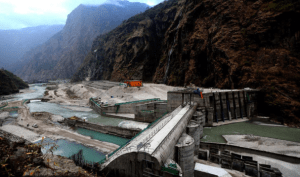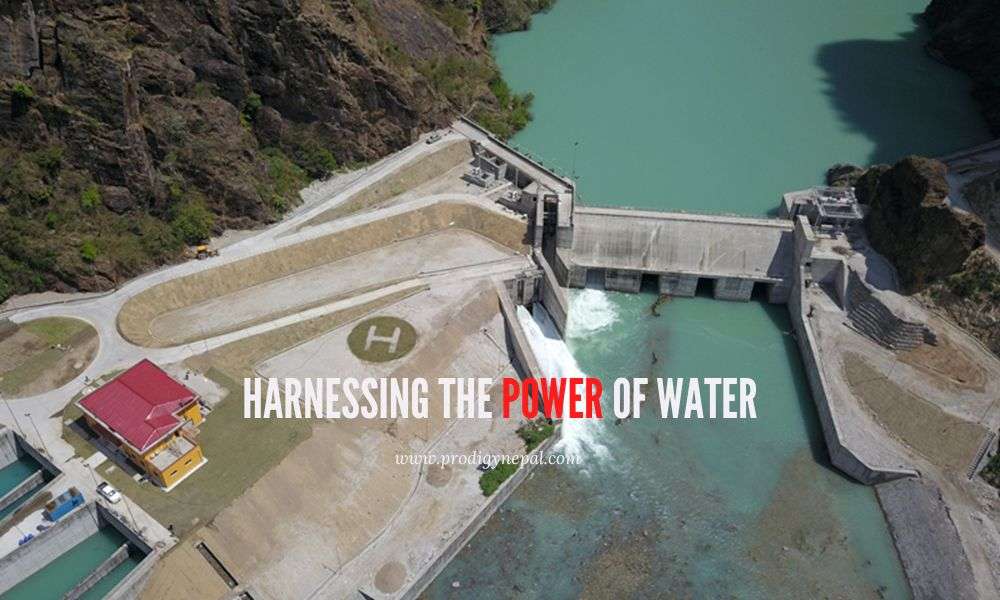Exploring Potential of the Hydropower in Nepal
In a world striving for sustainable energy solutions, the age-old force of water has emerged as a powerful ally. Hydropower, a renewable energy source, has been harnessed for centuries to generate electricity, drive machinery, and even transform landscapes. As concerns about climate change and environmental degradation intensify, the significance of hydropower in the global energy mix becomes more pronounced.
Hydropower holds a pivotal role in the global pursuit of sustainable energy sources. As a renewable and clean energy option, it not only provides a reliable and consistent power supply but also contributes to reducing greenhouse gas emissions and mitigating the impacts of climate change. Hydropower’s ability to generate electricity from the natural flow of rivers and watercourses makes it a dependable source, unaffected by the intermittency associated with solar and wind energy.
Moreover, its versatility extends beyond electricity generation, often facilitating irrigation, flood control, and water supply management. With its potential to meet growing energy demands while fostering environmental preservation, hydropower stands as a cornerstone in the transition towards a greener and more secure energy future.
Mechanics of Hydropower in Nepal: Turning Water into Electricity
At its core, hydropower involves converting the kinetic energy of flowing water into mechanical energy, which is then transformed into electricity. This process revolves around dams or diversion structures that alter the natural flow of a river, creating a reservoir or a controlled water channel.
As water is released from these structures, its movement drives turbines, which in turn activate generators to produce electrical power. The beauty of hydropower lies in its reliability – unlike solar or wind energy, it isn’t contingent on unpredictable weather patterns.

Types of Hydropower Systems: Diverse Approaches to Energy Generation
There are several variations of hydropower systems, each tailored to the specific geographical and hydrological conditions of a region. The most common types include:
- Run-of-the-River Systems: These systems don’t require a large reservoir. Instead, they divert a portion of the river’s flow through turbines, generating electricity without significantly altering the watercourse.
- Reservoir Systems: Large dams create reservoirs that store water. The controlled release of this water through turbines produces electricity on demand.
- Pumped Storage Hydropower: This innovative system acts as a giant battery. Excess electricity is used during periods of low demand to pump water from a lower reservoir to a higher one. During peak demand, water flows back down, generating electricity as it passes through turbines.
Also Read: Top 10 Largest Cities in Nepal
Environmental Impact and Sustainability
While hydropower is celebrated for its renewable nature, it’s not without environmental considerations. The construction of dams can lead to altered ecosystems and the displacement of communities. The accumulation of sediment in reservoirs can affect downstream habitats and water quality.
However, advancements in technology and a growing emphasis on sustainable practices have led to the development of “run-of-the-river” projects that minimize ecological disruptions.
Global Significance and Future Prospects
Hydropower’s global importance cannot be overstated. It accounts for a significant portion of the world’s electricity generation and plays a crucial role in meeting energy demands, especially in regions with abundant water resources.
In recent years, there has been renewed interest in hydropower due to its potential to store excess renewable energy, effectively integrating intermittent sources like solar and wind into the grid.
As the world transitions towards cleaner energy alternatives, hydropower’s versatility and reliability position it as a critical component of a sustainable energy future. By addressing environmental concerns through responsible project planning and technology innovation, we can harness the power of water to drive positive change on a global scale.
Nepal’s Hydropower Potential: A Blueprint for Sustainable Energy
Nepal, nestled in the Himalayas, is a country blessed with a unique geography that holds immense hydropower potential. The rushing rivers and steep gradients offer a natural canvas for tapping into this renewable energy source, making Nepal a shining example of how hydropower can transform a nation’s energy landscape and contribute to its sustainable development.
Nepal boasts a network of more than 6000 rivers, spanning a total length of 45000 km. These water bodies collectively cover about 3.9 percent of Nepal’s entire land area. The primary sources of water stem from the icy mountains and glacial lakes within the region.
The ownership of most of Nepal’s hydroelectric projects is divided between the Nepal Electricity Authority (NEA) and various Independent Power Producers. As we look ahead, several hydroelectric projects that are presently in the construction phase are poised for completion. Currently, run-of-river hydropower projects constitute the predominant share of Nepal’s hydropower capacity.
History of Hydropower in Nepal

The initiation of Nepal’s hydropower development began with the installation of 500 kW of electricity at Pharping, known as Chandra Jyoti, on May 22, 1911. Subsequently, after a span of 25 years, Prime Minister Dev Shamsher commenced the Sundarijal Hydropower Plant with capacities of 900 kW and 640 kW in 1936.
For an extended period, this marked a significant advancement in hydroelectric development within Nepal. Following this, in 1939, the Morang Hydropower Company engaged in a public-private partnership, culminating in the construction of the Letang hydropower plant in 1943, boasting an installed capacity of 1800 kW. This plant, which powered the Biratnagar Jute Mill, eventually faced destruction due to a landslide.
The establishment of the Koshi and Gandak Projects in 1954 and 1959, designed to address Nepal’s irrigation needs while simultaneously serving as hydroelectric sources, constituted the country’s inaugural bilateral agreements with India.
Over time, Nepal’s electricity demand surged from 557 MW in 2005 to 1200 MW in 2013. By 2013, the available hydropower capacity totaled 733 MW, of which 255 MW was operated by the commercial sector, while the Nepal Electricity Authority (NEA) owned 478 MW.
Correspondingly, electricity consumption followed an upward trajectory from an anticipated 105 GWh in 2006–2007 to 678 GWh in 2009–2010, reaching a temporary peak of 745 GWh in 2008–2009. The primary factor contributing to this challenge was the dominance of run-of-river (RoR) hydropower units, except those with a storage capacity of 92 MW.
Addressing the growing energy needs, the Upper Tamakoshi Hydropower Plant emerged as a significant milestone in Nepal’s energy transition. Situated about six kilometers from the Tibetan border within the upper Himalayas in the Tamakoshi River basin, this monumental project features six underground units and a natural head of 822 meters.
Expected to produce up to 2,281 GWh of energy annually, the Upper Tamakoshi plant is poised to contribute significantly to the nation’s economic growth and raise living standards, all while harnessing renewable energy sources.
Abundant Water Resources and Untapped Potential
Nepal boasts an extensive network of rivers and streams that are fed by the snowmelt and monsoon rains from its towering mountains. This abundance of water resources holds the key to unlocking substantial hydropower potential. In fact, estimates suggest that Nepal’s theoretical hydropower potential exceeds 83,000 megawatts, far surpassing its current energy demand.
Challenges and Opportunities
Despite its rich potential, Nepal’s journey towards harnessing its hydropower resources has encountered challenges. Limited financial resources, regulatory complexities, and technological limitations have slowed down the development of hydropower projects. Additionally, environmental concerns and the need to mitigate potential impacts on ecosystems and local communities have led to careful deliberation in project planning.
However, these challenges have also paved the way for opportunities. Nepal’s commitment to sustainable development aligns well with the principles of responsible hydropower development. By adopting best practices, employing advanced technology, and engaging in community consultations, Nepal can create a blueprint that showcases how hydropower projects can harmonize with both nature and society.
Major Hydropower Projects in Nepal
Several notable hydropower projects are in various stages of development in Nepal:
- Upper Tamakoshi Hydropower Project: Set to become Nepal’s largest hydropower project, the Upper Tamakoshi aims to generate around 456 megawatts of electricity. It’s situated in the Dolakha district and is expected to significantly contribute to Nepal’s energy needs.
- Bheri Babai Diversion Multipurpose Project: This multipurpose project is not only focused on energy generation but also on irrigation and flood control. It highlights Nepal’s strategy of integrating hydropower with other development objectives.
- Gatlang Hydropower Project: With a unique underground powerhouse concept, the Gatlang project showcases Nepal’s innovative approach to optimizing its hydropower potential while minimizing environmental and social impacts.
Sustainable Development through Hydropower
Nepal’s pursuit of harnessing its hydropower potential aligns with its commitment to sustainable development goals. By investing in clean energy, the nation can reduce its dependence on fossil fuels, mitigate greenhouse gas emissions, and pave the way for economic growth.
Moreover, the revenue generated from hydropower can be reinvested in social welfare programs, education, and infrastructure, benefiting local communities and the nation as a whole.
Major Issues/Obstacles
Although significant developments have unfolded within Nepal’s hydropower sector, the industry continues to grapple with a host of challenges. Several of these issues are outlined below.
Absence of Policy Interventions
The goal of Nepal’s first comprehensive hydropower laws, which were released in the early 1990s, was to prevent deforestation and close the supply-demand gap. Other objectives included obtaining money from the private sector for infrastructure development and utilizing domestic resources for hydropower development.
The slower rate of pblic sector hydropower development is a definite setback for planners who had hoped that an alluring hydropower policy would attract additional investment capital to Nepal.
Market failure in financial intermediaries (FIS)
Market failure appears to be significant due to the short-term nature of the deposit base (the debts supplied by the banks and their capital base are limited), and it will be a portfolio mismatch for them to make long-term loans.
Therefore, FIS seems reluctant to help private entrepreneurs take the necessary share in hydropower development.
Topological Difficulty
India borders Nepal on three sides (the south, the east, and the west), and Tibet Autonomous Region of China borders Nepal on the north. Between Nepal and Bangladesh is the tiny Siliguri corridor, also known as the chicken’s neck of West Bengal.
Long transmission lines are needed due to the challenging terrain and dispersed settlements, and connecting to national or regional grids may cost two to five times as much as producing electricity in large, centralized plants.
Fragile Structure
The Himalaya is the world’s most dynamic and vulnerable mountain range, frequently referred to as a live mountain with active tectonics. The Himalaya is still rising and its rocks are constantly under pressure because the Indian plate, which is moving toward the north, is pushing against the more stable Tibetan block.
The Himalaya is compelled by this pressure to rise and shift horizontally southward along large thrusts, which is frequently reflected in a high frequency of earthquakes. The Himalaya is also fundamentally vulnerable due to the rocks’ poor geological features.
Key takeaway
The demand for electrical energy over all other forms of energy, as well as the total installed capacity for power generation in Nepal, are hot topics. The government’s top priority should be to focus all of its efforts in a single direction to provide power as customers desire in order to energize the whole economic sector.
In addition, the Hydropower in Nepal & hydro-electricity industry in Nepal attracts a lot of private sector developers and large-scale domestic and foreign investors in addition to the public sector. Fundamentally, hydropower’s enormous potential and incredible dominance in the electricity industry, which essentially has prolonged parturition in the form of capital investment, make it the investment hotspot in Nepal.
Therefore, by weighing the advantages and disadvantages, challenges and chances, and ups and downs of Nepal’s hydropower growth, one may basically identify the greater weight of potential prospects and act accordingly.
Conclusion
Nepal stands at the crossroads of a renewable energy revolution, where the flow of its rivers can power not only its homes and industries but also its aspirations for a brighter future.
By addressing challenges with innovative solutions and adhering to sustainable practices, Nepal can set an inspiring example for other nations seeking to maximize their hydropower potential while safeguarding their environment and fostering inclusive development.


![Top 10 Best Digital Wallets in Nepal [Updated]](https://prodigynepal.com/wp-content/uploads/2024/03/Best-Digital-wallets-in-Nepal.jpg)
